The Laboratory Shakers Market is estimated to be valued at USD 3.5 billion in 2025 and is projected to reach USD 5.4 billion by 2035, registering a compound annual growth rate (CAGR) of 4.5% over the forecast period.
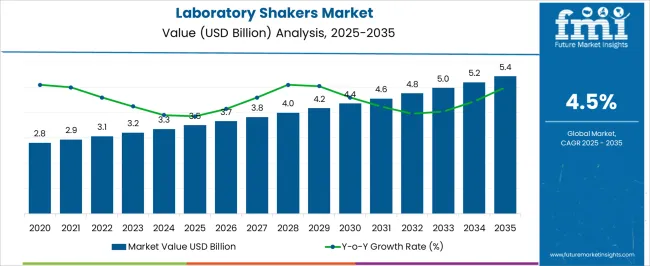
| Metric | Value |
|---|---|
| Laboratory Shakers Market Estimated Value in (2025 E) | USD 3.5 billion |
| Laboratory Shakers Market Forecast Value in (2035 F) | USD 5.4 billion |
| Forecast CAGR (2025 to 2035) | 4.5% |
The Laboratory Shakers market is experiencing steady growth due to the rising demand for automated and precise mixing equipment across research laboratories, pharmaceutical development, and biotechnology sectors. The market is being shaped by increasing investments in laboratory infrastructure, the expansion of research activities, and the growing need for reproducible and efficient sample handling.
Technological advancements in shaker designs, including programmable operation and enhanced motion control, are enabling improved experiment accuracy and throughput. The ability to support multiple applications such as cell culture, chemical dissolution, and molecular biology experiments is driving adoption.
Additionally, regulatory emphasis on laboratory safety and process standardization has increased the preference for reliable and certified shaking equipment As laboratory processes continue to become more complex and time-sensitive, shakers that provide consistent motion, precise control, and adaptability are expected to remain in high demand, offering opportunities for market expansion and product differentiation.
The laboratory shakers market is segmented by type, operation, motion of direction, end use, and geographic regions. By type, laboratory shakers market is divided into Orbital Laboratory Shakers, Vortex Laboratory Shakers, Rocking Laboratory Shakers, Incubator Laboratory Shakers, Biological Laboratory Shakers, Vibrating Laboratory Shakers, Nutating Laboratory Shakers, Reciprocating Laboratory Shakers, Sieve Laboratory Shakers, and Miscellaneous Laboratory Shakers. In terms of operation, laboratory shakers market is classified into Open Air Shaker, Enclosed (Incubating) Shaker, Stacked Shaker, and Water – Bath Shaker. Based on motion of direction, laboratory shakers market is segmented into Reciprocating Linear Motion, Orbiting Motion, and Dual Motion. By end use, laboratory shakers market is segmented into Commercial & Institutional Laboratories and Industrial Laboratories. Regionally, the laboratory shakers industry is classified into North America, Latin America, Western Europe, Eastern Europe, Balkan & Baltic Countries, Russia & Belarus, Central Asia, East Asia, South Asia & Pacific, and the Middle East & Africa.
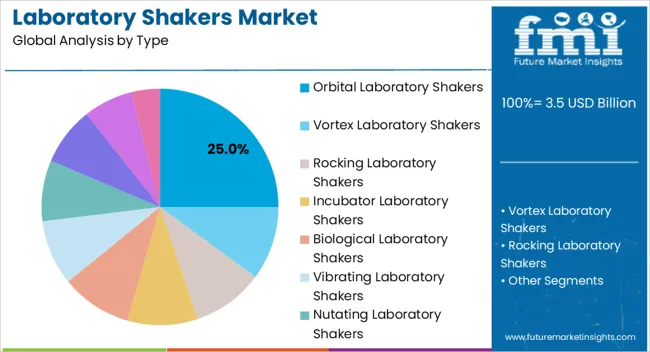
The Orbital Laboratory Shakers type is projected to hold 25.00% of the Laboratory Shakers market revenue share in 2025, making it a leading product type. This dominance is attributed to its ability to provide uniform mixing and agitation across a range of laboratory samples. The orbital motion ensures gentle but thorough mixing, which is especially important for sensitive biological and chemical samples.
Adoption has been accelerated in applications requiring consistent reproducibility, as well as in laboratories seeking low maintenance and long-lasting equipment. The segment’s growth is being reinforced by its compatibility with multi-platform trays and the capacity to support various vessel sizes, enhancing operational efficiency.
Additionally, the precision control and stability offered by orbital shakers have encouraged their integration into automated workflows, reducing manual intervention and improving overall laboratory productivity The flexibility and reliability of these shakers make them highly preferred across research and commercial laboratory environments.
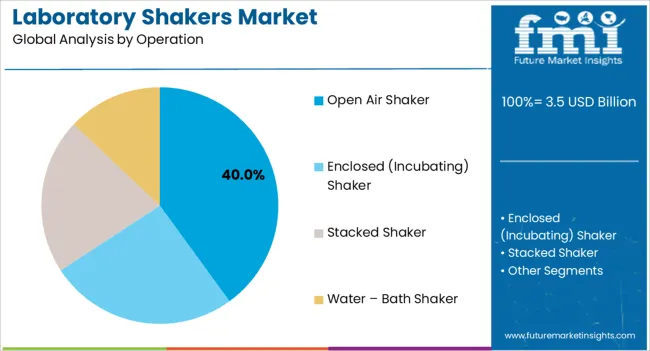
The Open Air Shaker operation segment is expected to account for 40.00% of the Laboratory Shakers market revenue in 2025, positioning it as the largest operational category. Its leading position is being driven by the ability to provide direct airflow and heat dissipation, which improves sample stability during agitation. Open air shakers are widely adopted in applications that require rapid drying, aeration, or precise temperature control.
The segment’s growth has been reinforced by the growing emphasis on high-throughput laboratory operations and process efficiency. Laboratories favor these shakers for their ease of maintenance, low operational complexity, and compatibility with a variety of laboratory vessels.
Additionally, open air designs allow for simple cleaning and reduced contamination risk, which is essential in pharmaceutical and biotechnological laboratories The continued demand for reliable, scalable, and versatile shakers is expected to further support the expansion of this operational segment.
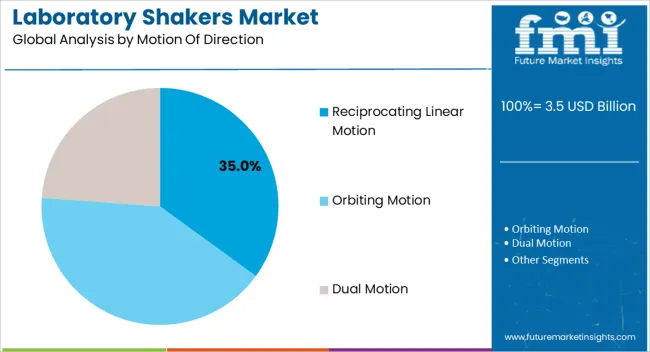
The Reciprocating Linear Motion segment is anticipated to hold 35.00% of the Laboratory Shakers market revenue in 2025, highlighting its significant adoption in laboratories. This motion type is preferred for applications requiring high agitation intensity and rapid sample mixing, including chemical dissolution, sample homogenization, and suspension of particulate matter. Growth in this segment is being driven by the consistent performance delivered across a variety of sample sizes and viscosities.
Reciprocating linear motion shakers are valued for their ability to maintain uniform motion and reduce variability in experimental outcomes. Their design supports modular tray configurations and easy scalability, which enhances laboratory efficiency.
Furthermore, the simplicity of operation, durability, and low maintenance requirements have encouraged their widespread deployment across research, pharmaceutical, and industrial laboratories The segment’s adaptability and operational precision are expected to continue driving its market leadership.
Laboratory shakers are the instruments used in institutional, industrial and independent R&D laboratories that assist in the formation of a homogenous mixture of more than one components. In common practice, laboratory shakers are confused with laboratory mixers which are technically distinguished on the basis of the type of flow created inside the flask, test tube or vial placed inside the equipment.
While the laboratory shakers create a laminar flow to maintain uniformity in the mixture due to the uniform motion of the underlying platform, laboratory mixers have a tool such as a blade or paddle dipped inside the sample and agitating it mechanically, creating turbulence in the solution.
There has been extensive innovation pertaining to the laboratory equipments and as a result, there are several types of laboratory shakers available in the market. The growing interest of designers towards venturing in the untapped markets lead to product innovation and also assist the market players in product differentiation.
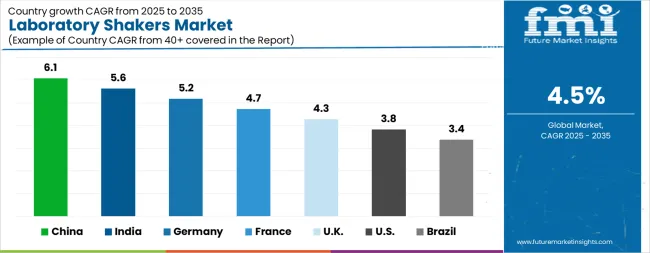
| Country | CAGR |
|---|---|
| China | 6.1% |
| India | 5.6% |
| Germany | 5.2% |
| France | 4.7% |
| UK | 4.3% |
| USA | 3.8% |
| Brazil | 3.4% |
The Laboratory Shakers Market is expected to register a CAGR of 4.5% during the forecast period, exhibiting varied country level momentum. China leads with the highest CAGR of 6.1%, followed by India at 5.6%. Developed markets such as Germany, France, and the UK continue to expand steadily, while the USA is likely to grow at consistent rates. Brazil posts the lowest CAGR at 3.4%, yet still underscores a broadly positive trajectory for the global Laboratory Shakers Market. In 2024, Germany held a dominant revenue in the Western Europe market and is expected to grow with a CAGR of 5.2%. The USA Laboratory Shakers Market is estimated to be valued at USD 1.3 billion in 2025 and is anticipated to reach a valuation of USD 1.9 billion by 2035. Sales are projected to rise at a CAGR of 3.8% over the forecast period between 2025 and 2035. While Japan and South Korea markets are estimated to be valued at USD 169.2 million and USD 88.4 million respectively in 2025.
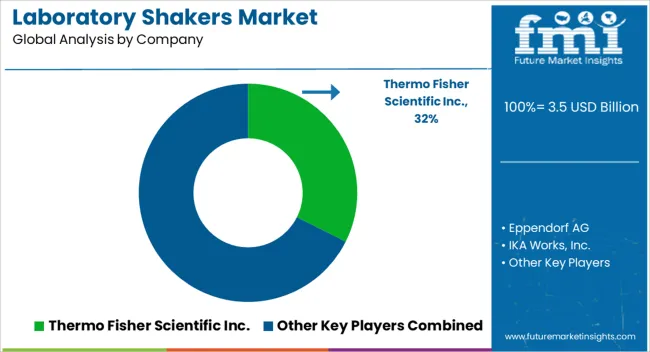
| Item | Value |
|---|---|
| Quantitative Units | USD 3.5 Billion |
| Type | Orbital Laboratory Shakers, Vortex Laboratory Shakers, Rocking Laboratory Shakers, Incubator Laboratory Shakers, Biological Laboratory Shakers, Vibrating Laboratory Shakers, Nutating Laboratory Shakers, Reciprocating Laboratory Shakers, Sieve Laboratory Shakers, and Miscellaneous Laboratory Shakers |
| Operation | Open Air Shaker, Enclosed (Incubating) Shaker, Stacked Shaker, and Water – Bath Shaker |
| Motion Of Direction | Reciprocating Linear Motion, Orbiting Motion, and Dual Motion |
| End Use | Commercial & Institutional Laboratories and Industrial Laboratories |
| Regions Covered | North America, Europe, Asia-Pacific, Latin America, Middle East & Africa |
| Country Covered | United States, Canada, Germany, France, United Kingdom, China, Japan, India, Brazil, South Africa |
| Key Companies Profiled | Thermo Fisher Scientific Inc., Eppendorf AG, IKA Works, Inc., Benchmark Scientific Inc., Corning Incorporated, Heidolph Instruments GmbH & Co. KG, Sartorius AG, and Labnet International Inc. |
The global laboratory shakers market is estimated to be valued at USD 3.5 billion in 2025.
The market size for the laboratory shakers market is projected to reach USD 5.4 billion by 2035.
The laboratory shakers market is expected to grow at a 4.5% CAGR between 2025 and 2035.
The key product types in laboratory shakers market are orbital laboratory shakers, vortex laboratory shakers, rocking laboratory shakers, incubator laboratory shakers, biological laboratory shakers, vibrating laboratory shakers, nutating laboratory shakers, reciprocating laboratory shakers, sieve laboratory shakers and miscellaneous laboratory shakers.
In terms of operation, open air shaker segment to command 40.0% share in the laboratory shakers market in 2025.






Our Research Products

The "Full Research Suite" delivers actionable market intel, deep dives on markets or technologies, so clients act faster, cut risk, and unlock growth.

The Leaderboard benchmarks and ranks top vendors, classifying them as Established Leaders, Leading Challengers, or Disruptors & Challengers.

Locates where complements amplify value and substitutes erode it, forecasting net impact by horizon

We deliver granular, decision-grade intel: market sizing, 5-year forecasts, pricing, adoption, usage, revenue, and operational KPIs—plus competitor tracking, regulation, and value chains—across 60 countries broadly.

Spot the shifts before they hit your P&L. We track inflection points, adoption curves, pricing moves, and ecosystem plays to show where demand is heading, why it is changing, and what to do next across high-growth markets and disruptive tech

Real-time reads of user behavior. We track shifting priorities, perceptions of today’s and next-gen services, and provider experience, then pace how fast tech moves from trial to adoption, blending buyer, consumer, and channel inputs with social signals (#WhySwitch, #UX).

Partner with our analyst team to build a custom report designed around your business priorities. From analysing market trends to assessing competitors or crafting bespoke datasets, we tailor insights to your needs.
Supplier Intelligence
Discovery & Profiling
Capacity & Footprint
Performance & Risk
Compliance & Governance
Commercial Readiness
Who Supplies Whom
Scorecards & Shortlists
Playbooks & Docs
Category Intelligence
Definition & Scope
Demand & Use Cases
Cost Drivers
Market Structure
Supply Chain Map
Trade & Policy
Operating Norms
Deliverables
Buyer Intelligence
Account Basics
Spend & Scope
Procurement Model
Vendor Requirements
Terms & Policies
Entry Strategy
Pain Points & Triggers
Outputs
Pricing Analysis
Benchmarks
Trends
Should-Cost
Indexation
Landed Cost
Commercial Terms
Deliverables
Brand Analysis
Positioning & Value Prop
Share & Presence
Customer Evidence
Go-to-Market
Digital & Reputation
Compliance & Trust
KPIs & Gaps
Outputs
Full Research Suite comprises of:
Market outlook & trends analysis
Interviews & case studies
Strategic recommendations
Vendor profiles & capabilities analysis
5-year forecasts
8 regions and 60+ country-level data splits
Market segment data splits
12 months of continuous data updates
DELIVERED AS:
PDF EXCEL ONLINE
Laboratory Rockers and Shakers Market Size and Share Forecast Outlook 2025 to 2035
Laboratory Precision Oven Market Size and Share Forecast Outlook 2025 to 2035
Laboratory Information System Market Forecast and Outlook 2025 to 2035
Laboratory Centrifuge & Accessories Market Size and Share Forecast Outlook 2025 to 2035
Laboratory Washers Market Size and Share Forecast Outlook 2025 to 2035
Laboratory Filtration Devices Market Size and Share Forecast Outlook 2025 to 2035
Laboratory and Medical Scale Ozone Generator Market Size and Share Forecast Outlook 2025 to 2035
Laboratory Furnaces Market Analysis - Size, Share, and Forecast 2025 to 2035
Laboratory Supplies Market Size and Share Forecast Outlook 2025 to 2035
Laboratory Benchtop Automation Market Growth – Trends & Forecast 2025 to 2035
Laboratory Balances and Scales Market Growth - Industry Forecast 2025 to 2035
Global Laboratory Filter Paper Market Growth – Trends & Forecast 2024-2034
Laboratory Sample Container Market
Laboratory Filtration Equipment Market Growth – Trends & Forecast 2019-2027
Laboratory Glassware and Plasticware Market
Laboratory Ovens Market Analysis by Mechanical Convection and Vacuum Ovens Type through 2035
AI in Laboratory Solution Market Size and Share Forecast Outlook 2025 to 2035
Dental Laboratory Market Size and Share Forecast Outlook 2025 to 2035
Laboratory Grinders Market Size and Share Forecast Outlook 2025 to 2035
Service Laboratory Market Analysis by Service Type, Deployment, Channel, End-user, and Region Through 2035

Thank you!
You will receive an email from our Business Development Manager. Please be sure to check your SPAM/JUNK folder too.
Chat With
MaRIA